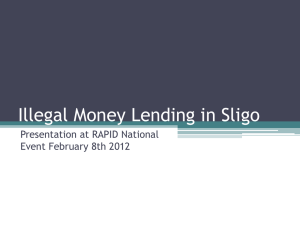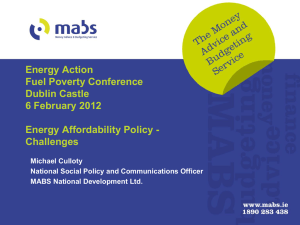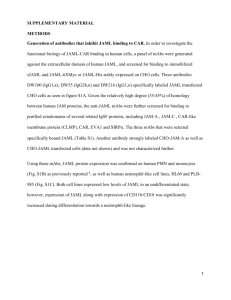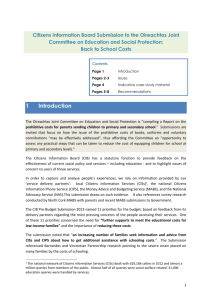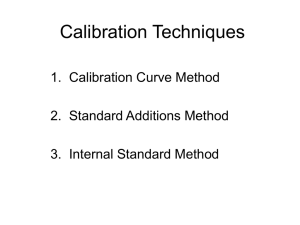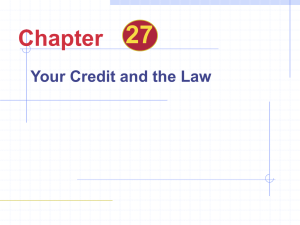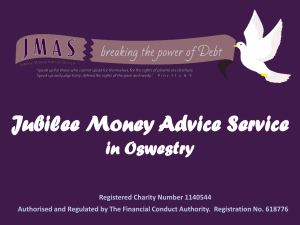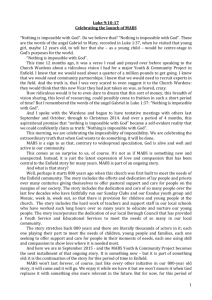MABS Mission Statement
advertisement
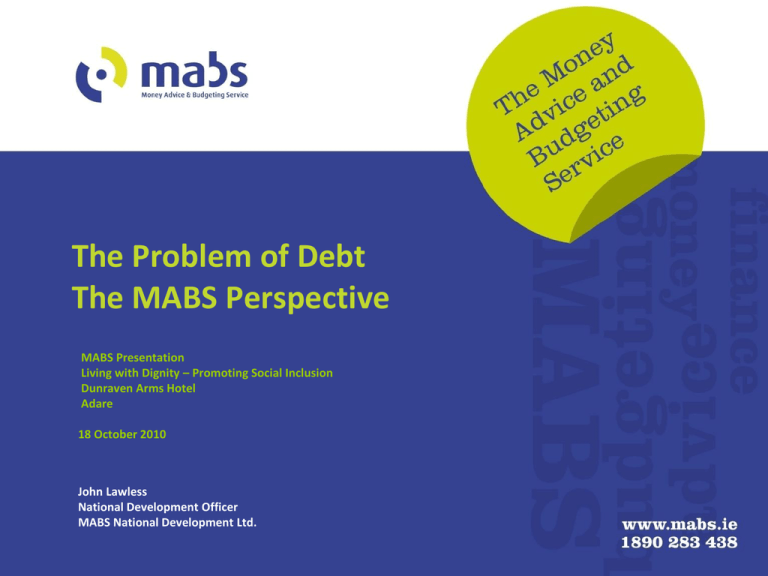
The Problem of Debt The MABS Perspective MABS Presentation Living with Dignity – Promoting Social Inclusion Dunraven Arms Hotel Adare 18 October 2010 John Lawless National Development Officer MABS National Development Ltd. What is MABS? • The Money Advice and Budgeting Service is the only free, independent, confidential and non-judgmental service, providing one-to-one advice to people having difficulty managing their money, are in debt or are in danger of being in debt. • The service is funded and supported by the Citizens Information Board • • MABS Local - over 60 services nationwide Limerick Office: Unit 9, Tait Business Centre, Dominic Street, Limerick. • MABS Website – www.mabs.ie • MABS Helpline -1890 283 438 MABS Mission Statement To work towards the elimination of over-indebtedness through the provision of an accessible, free, confidential, independent, community and rights based Money Advice & Budgeting Service. One of the Aims of MABS is to prevent: • Homelessness • Fuel Disconnection (ESB, heating, cooking) • The exclusion of the person from access to essential services (School, Water, transport, clothing, medical) • The loss of Liberty Source MABS Mission Statement MABS seeks to achieve this mission by • Identifying, supporting, and educating those experiencing or at risk of over-indebtedness especially those experiencing inequality in terms of access to financial services • Facilitating empowerment of its Clients in a non-judgemental way • Using the knowledge and experience gained from working with Clients to bring about changes in policy and practice on poverty and debt related issues National Traveller MABS • National Traveller MABS seeks to empower by supporting capacity building within the Traveller community and ensuring equality of access to legal and affordable financial services for all One of the Strategic Priorities is: • Equality across all financial and related services: To work with internal and external bodies to promote equality and diversity within financial services Causes of Debt Money difficulties can arise for various reasons The most common reasons in our experience are: • Changes in life’s circumstance • Illness • Unemployment • Relationship breakdown • Over borrowing Slippery Slope to Insolvency • Stage One The Debt Trigger unemployment, illness, etc. • Stage Two Initial Missed Payment beginning of creditor pressure • Stage Three Robbing Peter to pay Paul the spread of debt • Stage Four Multiple Debts multiple pressure • Stage Five Contact with Creditor promise to repay • Stage Six Broken Promises further increased pressure Slippery Slope to Insolvency contd. • Stage Seven Personal Reaction depression, denial, strain on family relationships, fear, isolation • Stage Eight Legal Pressure letters from creditors, letters from solicitors, court summonses, court orders • Stage Nine Financial Chaos enormous debt problems causing havoc • Stage Ten Facing Sanctions home, utilities, loss of essential items, possible imprisonment • Stage Eleven Further Losses marriage breakdown, deterioration of physical health, mental breakdown, suicide Psychological Effects • • • • • • • • • • • Blame (self/others) Conflict (partners) Constant tension and worry Denial Fear (of prison) Feeling helpless Frustration Guilt Hopelessness Isolation Loneliness • • • • • • • • • • • No end is sight No social life No-one with whom to share anxieties Pessimism Sense of going mad Shame Vulnerability Sleeplessness Stigma (neighbors) Stress and depression Suicidal tendencies MABS Approach...respecting the individual • Self Help approach..... Providing the resources for self help • Self Help with one to one assistance either on phone or in person • One to one consultations • Negotiations with creditors and advocacy • Ongoing support Case Assessment • • • • • • • • Financial Situation Nature of the debt(s) Urgency Capacity to Pay Capacity to deal with the issue(s) Vulnerability Personal Motivation Family & Social context Client Capacity • • • • • • Diminished capacity in a time of crisis Literacy or language difficulties Mental illness Addictions Education Debt crisis one element of an overarching crisis Client motivation Distinguish between Won’t Pay and Can’t pay. MABS Plan for Dealing with Debt A holistic mediated approach MABS Four Step Approach: Step 1: Assess the situation Step 2: Work out a budget Step 3: Make proposals to the creditors Step 4: Managing the payments What are Priority Debts? Some debts are more important than others. Important debts such as mortgage arrears, rent arrears, fines, and maintenance payments are called priority debts. Because: • The family home may be at risk • A client might be evicted • Electricity, gas or telephone may be disconnected • Failure to pay a fine or disobey a court order may result in a prison sentence • The car or goods on hire purchase could be repossessed. Secondary Debts These are debts where money has been loaned to a client without the client having to provide any security. The most common credit debts include: Examples • Bank Overdraft • Catalogue Debts • Credit Card Debts • Credit Sales Agreements • Credit Union Loans • Personal Debts to friends and family • Personal Loans with Banks and Finance companies . These are dealt with on a Pro Rata Basis Making proposals to creditors • • • • • A Budget is prepared A Standard Financial Statement is prepared. Verification of details on the Statement Proposals are made to the Creditors Priority Debts & Secondary Debts MABS relationship with creditors • • • • • • • An honest broker Protocols in place with many of the main creditors Irish Banking Federation members Utility companies Credit Unions Individual creditors Moneylenders Where to from here ...from the current context into the future • Rise in number of clients year on year • Increase in debt among self employed and middle class • The new poor • Huge increase with clients presenting with Mortgage arrears • Referrals to MABS from Credit Unions, Banks and building societies, Courts, Social Workers, CWO’s and Society of Vincent de Paul etc.

